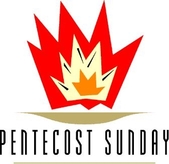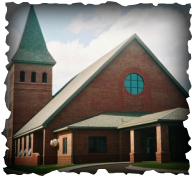Interesting Information
Check this page for facts about symbols, church structure, customs, traditions, etc.
Have a question about something that you don't see here - contact us and we'll see what we can find out about it.
Have a question about something that you don't see here - contact us and we'll see what we can find out about it.
PC (USA) SymbolThe meaning behind the symbol of the Presbyterian Church (USA).
https://oga.pcusa.org/section/stated-clerk/stated-clerk/seal/  Click on seal to learn about its symbolism What is Pentecost?
Pentecost marks the end of the Easter season.
It is the celebration of the beginning of the true church; a community in unity in the worship of Jesus Christ. Pentecost marks the first time the disciples gathered after Jesus' return to the Father and began to spread the word of the Lord to others. They had done this while Jesus lived, but this was the first time they had a mission that came from beyond themselves and the leader they were following here on earth. Pentecost marks the day that they spoke to a gathering of people who spoke different languages but still heard the "Word" in their own tongue. As Pentecost is a day of celebration it is often marked by the wearing of red clothes, boisterous singing, and a general celebratory attitude. When is Easter and Why Does the Date Change? The Easter holiday moves each year because the actual Easter date is calculated by choosing the first Sunday after the full moon following the spring equinox.
This was originally decided at the Council of Nicaea in 325 AD. The Roman Emperor Constantine I assembled the early Christian leaders from across Europe and the Middle East to fix matters of doctrine and dates of important Christian events such as the date of the Easter festival. Easter has been celebrated according to this moving calendar ever since. What is Lent? Lent begins on Ash Wednesday and continues through Holy Week with Maundy Thursday, Good Friday, and concluding the Saturday before Easter.
This time frame known as Lent is marked by a time of prayer and preparation to celebrate Easter. Since Sundays celebrate the resurrection of Jesus, the six Sundays that occur during Lent are not counted as part of the 40 days of Lent, and are referred to as the Sundays in Lent. The 40 days are symbolic of the 40 days Jesus spent in the wilderness preparing for His ministry by facing the temptations that could lead him to abandon his mission and calling. It is atime of preparation to clebrate God's marvelous redemtion at Easter, and the resurrected life that we live, and hope for as Christians. 
Ash Wednesday is the first day of Lent. It is marked by the placing of ashes on the forehead of believers as a symbol of their mourning and repentance. The ashes used are generally gathered from the burning of the Palms from the previous Palm Sunday.
Holy Week - the last week of Lent and the week before Easter Maundy Thursday - commemorates the Last Supper of Christ Good Friday - commemorates the crucifixion and death of Jesus Christ. |
What Does "IHS" mean?
There are many creative interpretations of this sign, often found stitched into paraments or inscribed on brass crosses - "In His Service," "I Have Suffered," "Iesus Hominum Salvator" (Jesus, Savior of Humanity), or "In Hoc Signo" (In This Sign). These are all "backronyms", however - spurious acronyms created after the fact. The symbol is actually an ancient monogram for Christ (or Christogram), derived from the first three letters of "Jesus" in Greek: iota - eta - sigma:
Ι Η Σ Ο Υ Σ.
What Does "INRI" Mean?
"Pilate also wrote an inscription and put it on the cross. It was written, “JESUS THE NAZARENE, THE KING OF THE JEWS.” Therefore many of the Jews read this inscription, for the place where Jesus was crucified was near the city; and it was written in Hebrew, Latin, and in Greek."
John 19:19-20 The acronym INRI represents the Latin inscription IESVS·NAZARENVS·REX·IVDÆORVM (Iesus Nazarenus, Rex Iudaeorum), in English it reads as "Jesus the Nazarene, King of the Jews". The Greek version reads ΙΝΒΙ. What Does "Hanging of the Greens" Mean?
The beginning of Advent is a time for the "Hanging of the Green"; decorating with evergreen wreathes, boughs, or trees that help to symbolize the new and everlasting life brought through Jesus Christ.
HOLLY The hanging of greens, such as Holly, Ivy, and Mistletoe is a British winter tradition with origins far before the Christian era. Greenery was used to lift people's spirits during the long winter and remind them that spring was not far away. The Romans used holly during their solstice celebration as it was believed to ward off evil spirits. When Christianity spread across Europe, holly became synonymous with the word "holy". It invoked great symbolism, its prickly leaves represented the crown of thorns worn by Jesus and the bright red berries represent the drops of blood He shed on the cross. Holly is used to symbolize eternal life. WREATHS The roundness of the wreath and the sharpness of its pointed holly leaves symbolize Christ's crown of thorns and its red berries the drops of Christ's blood. The evergreen boughs often used to make it symolize everlasting life. As it is a circle with no beginning or end, it represents God's continuous love and the soul's immortality. ADVENT WREATH There are four candles around a central candle. The four outside candles consist of three purple and one pink. The central candle is white and is lit Christmas Eve or Christmas Day. The candles are traditionally lit in the following order; purple, purple, pink, purple, white. The first is called the "Candle of Hope." It symbolizes faith in God keeping his promises to humanity. The second is called the "Candle of Preparation," reminding Christians to "get ready" to receive God. The third candle is the "Candle of Joy." It recalls the angels joyfully singing about the birth of Christ. The fourth candle, the "Candle of Love,' reminds Christians that God loves them enough to send his only Son to Earth. The "Christ Candle," the white candle in the center, stands for Jesus Christ himself. IVY In pagan religions ivy had been a symbol of eternal life. Christians believe it stands for the new promise of eternal life. MISTLETOE For hundreds of years before the birth of Christ, the ancient Druids used mistletoe to celebrate the winter solstice. The Druids gathered the parasitic evergreen plant and used it to decorate their homes. As mistletoe is a parasite and grows without roots on other trees; it was believed that it came from heaven. The Druids had an affinity with nature and believed the plant to have special healing powers for a variety of ills from female infertility to poisoning. The custom of kissing under the mistletoe probably originated with the Scandinavians. They believed that mistletoe was the plant of peace and harmony and associated it with their goddess of love, Frigga. The early Christian church banned the use of mistletoe in Christmas celebrations because of its pagan origins and they favored the use of holly as an appropriate substitute for the Christmas greenery, conveniently forgetting the pagan origins of holly. In today's time mistletoe is used merely as an excuse for having a little fun at Christmas parties. |

